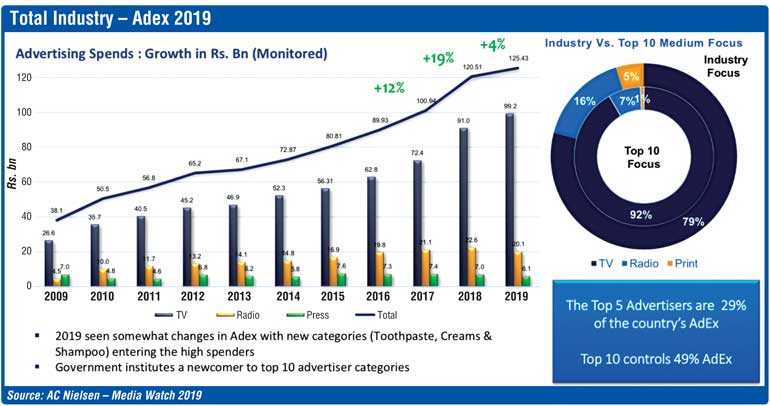Tuesday Jan 21, 2025
Tuesday Jan 21, 2025
Tuesday, 29 September 2020 00:55 - - {{hitsCtrl.values.hits}}

Whilst things may seem normal to some businesses, anyone who is associated with the tourism sector knows that things are rough. Even the five star hotels that have local visitors during the weekend are running at a loss in a given month.
|
Media advertising is down by -23.6% Jan-July 2020
|
The industries associated with the hospitality sector like the vehicle hires business, beach boys, jewellery outlets are currently been impacted. The business of the restaurants in the city are down by almost half given the economic fallout.
The spiralling cost of living is putting pressure on the consumer wallet that is impacting trading. A point to note is that this is not unique to Sri Lanka given that the country registered a -1.6% GDP growth in the first quarter.
Global reality -4%?
Whilst there is a varying economic performance in difference countries. The reality is that social distancing measures are costing the global GDP almost 7-8% as per the calculations by Goldman Sachs.
However, a point to note is that as per the latest data from JP Morgan Chase the July Global retail sales has recovered to the pre pandemic levels which is encouraging to the Apparel sector of Sri Lanka. However, for this to turn to new orders will take some time.
Overall economic growth will be positive to China at +2% but other key economies are in the red with South Korea at -1%, US -4% and the UK is heading to a -10% which is the worst recession that the country will see in modern times. Overall the world will be in a recession as -4% with the EU touching -8% which is scary given that Sri Lanka’s Key markets for exports are the US and EU which are both in a recessionary situation.
SL media spend -23.4%
In the above backdrop Sri Lanka’s media spend has exceeded 125 billion rupees at rack rates in 2019 with TV registering the bulk of the share with an almost 99 billion spend growing at an 8% growth in 2019.
However, in 2020 the overall marketing spend is -23.6% to 55.3 billion for the period January-July. During the corresponding period the marketing spend was 72.3 billion in 2019 whilst in 2018 it was 66.7 billion.
There is entrenched competition with top three channels Hiru, Derana and Swarnavahini accounting for 56% of the total spend. As per the National Media Survey of LMRB, pre pandemic viewer behaviour was changing drastically with ‘Regular’ viewership declining by -5% whilst occasional viewership increasing by +78%. The viewership habits of the ‘rare’ was +28% which is interesting. Given that almost 600,000 new consumers came into the fray during the pandemic (may be the satellite viewers and regular overseas travellers) the above data would change for sure.
Programmatic marketing
In this backdrop we see a new trend emerging with the birth of programmatic marketing which stems from the concept programatic advertising.
Programmatic advertising is a process by which by automating the buying and selling of ad inventory in real-time through an automated bidding systems it enables brands or agencies to purchase ad impressions on publisher sites or apps within milliseconds through a sophisticated ecosystem. In other words media buying goes after the consumers than the media vehicle.
Whilst this concept may be new to Sri Lanka, globally it is worth around $122 billion. This accounts for almost 69% of the total digital media.
How it works
The methodology of media buying is similar to the traditional methods except that when advertisements are placed on digital media it is tracked right up the consumer. Google Ads allows reporting the statistics of the currently-run campaigns, with a delay ranging from a few hours to about a day for some of the metrics. Because programmatic uses real-time bidding, the reporting of programmatic campaign results is available practically the next minute.
If I do a deep dive how it happens is that a person clicks on a website. The website owner puts the ad impression up for auction (SSP). Advertisers offer bids for the impression (DSP). The highest bidder wins the ad impression. The ad is served on the website to the user. The user (hopefully!) clicks on the ad and converts.
Advantages
In simple ‘programmatic advertising’ is a technology that enables advertisers to automatically target audience. The audience is ‘selected’ because of certain metrics that are obtained through algorithms.
There are many advantages of programmatic marketing which would not be possible if ad placement was done manually. It allows advertisers to procure digital media without having to pre-negotiate a price, so one pays only for the relevant impression that they actually receive. They can also sign up for a minimum number of impressions or a minimum budget, which makes digital advertising more flexible, and they can buy digital media across publishers, which reduced administration costs.
Next steps
During the lockdown, there was a 288% growth in digital media in Sri Lanka. As we speak there are seven million YouTube users with 10 million impressions a day which reaches 31% of the population of the country. There are 6.2 million FB users which is incidentally 28% of the population, who spend 20 minutes per visit. By the way almost 44% of the FB users are outside the Western Province. Instagram on the other hand is growing at 587% since 2015 in Sri Lanka. However, a point to note is that there are 1.1 million users which can reach 5%.
Given this background may be programmatic advertising will be the way forward.
(The thoughts are the writer’s personal views and not the views of the organisations he serves in Sri Lanka or internationally.)